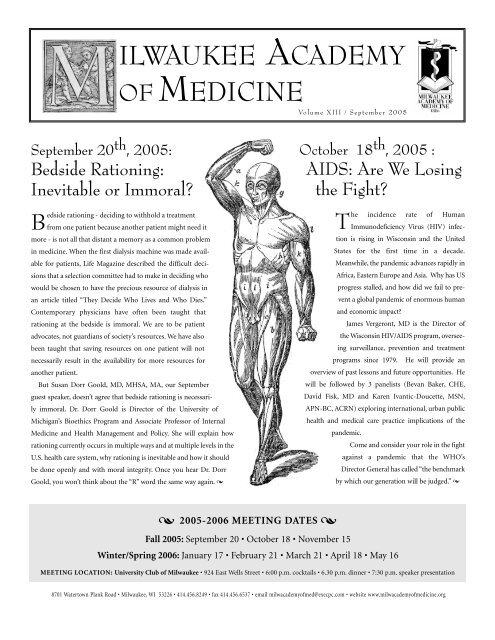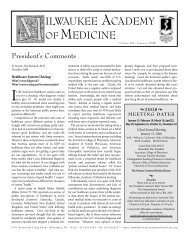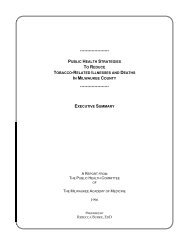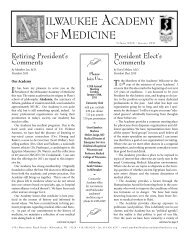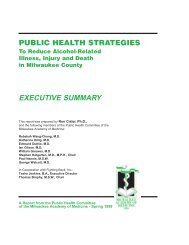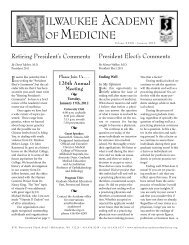September 2005 Newsletter - Milwaukee Academy of Medicine
September 2005 Newsletter - Milwaukee Academy of Medicine
September 2005 Newsletter - Milwaukee Academy of Medicine
You also want an ePaper? Increase the reach of your titles
YUMPU automatically turns print PDFs into web optimized ePapers that Google loves.
ILWAUKEE ACADEMY<br />
OF MEDICINE<br />
Vo l u m e X I I I / S e p t e m b e r 20 0 5<br />
<strong>September</strong> 20 th , <strong>2005</strong>:<br />
Bedside Rationing:<br />
Inevitable or Immoral?<br />
Bedside rationing - deciding to withhold a treatment<br />
from one patient because another patient might need it<br />
more - is not all that distant a memory as a common problem<br />
in medicine. When the first dialysis machine was made available<br />
for patients, Life Magazine described the difficult decisions<br />
that a selection committee had to make in deciding who<br />
would be chosen to have the precious resource <strong>of</strong> dialysis in<br />
an article titled “They Decide Who Lives and Who Dies.”<br />
Contemporary physicians have <strong>of</strong>ten been taught that<br />
rationing at the bedside is immoral. We are to be patient<br />
advocates, not guardians <strong>of</strong> society’s resources. We have also<br />
been taught that saving resources on one patient will not<br />
necessarily result in the availability for more resources for<br />
another patient.<br />
But Susan Dorr Goold, MD, MHSA, MA, our <strong>September</strong><br />
guest speaker, doesn’t agree that bedside rationing is necessarily<br />
immoral. Dr. Dorr Goold is Director <strong>of</strong> the University <strong>of</strong><br />
Michigan’s Bioethics Program and Associate Pr<strong>of</strong>essor <strong>of</strong> Internal<br />
<strong>Medicine</strong> and Health Management and Policy. She will explain how<br />
rationing currently occurs in multiple ways and at multiple levels in the<br />
U.S. health care system, why rationing is inevitable and how it should<br />
be done openly and with moral integrity. Once you hear Dr. Dorr<br />
Goold, you won’t think about the “R” word the same way again. <br />
October 18 th , <strong>2005</strong> :<br />
AIDS: Are We Losing<br />
the Fight?<br />
The incidence rate <strong>of</strong> Human<br />
Immunodeficiency Virus (HIV) infection<br />
is rising in Wisconsin and the United<br />
States for the first time in a decade.<br />
Meanwhile, the pandemic advances rapidly in<br />
Africa, Eastern Europe and Asia. Why has US<br />
progress stalled, and how did we fail to prevent<br />
a global pandemic <strong>of</strong> enormous human<br />
and economic impact?<br />
James Vergeront, MD is the Director <strong>of</strong><br />
the Wisconsin HIV/AIDS program, overseeing<br />
surveillance, prevention and treatment<br />
programs since 1979. He will provide an<br />
overview <strong>of</strong> past lessons and future opportunities. He<br />
will be followed by 3 panelists (Bevan Baker, CHE,<br />
David Fisk, MD and Karen Ivantic-Doucette, MSN,<br />
APN-BC, ACRN) exploring international, urban public<br />
health and medical care practice implications <strong>of</strong> the<br />
pandemic.<br />
Come and consider your role in the fight<br />
against a pandemic that the WHO’s<br />
Director General has called “the benchmark<br />
by which our generation will be judged.” <br />
<strong>2005</strong>-2006 MEETING DATES <br />
Fall <strong>2005</strong>: <strong>September</strong> 20 • October 18 • November 15<br />
Winter/Spring 2006: January 17 • February 21 • March 21 • April 18 • May 16<br />
MEETING LOCATION: University Club <strong>of</strong> <strong>Milwaukee</strong> • 924 East Wells Street • 6:00 p.m. cocktails • 6.30 p.m. dinner • 7:30 p.m. speaker presentation<br />
8701 Watertown Plank Road • <strong>Milwaukee</strong>, WI 53226 • 414.456.8249 • fax 414.456.6537 • email milwacademy<strong>of</strong>med@execpc.com • website www.milwacademy<strong>of</strong>medicine.org
From the <strong>Academy</strong>’s Rare Book Collection<br />
William Beaumont (1785-1853).<br />
Experiments and Observations<br />
on the Gastric Juice, and the<br />
Physiology <strong>of</strong> Digestion.<br />
Plattsburgh, F.P. Allen, 1833.<br />
Jesse S. Myer (1873-1913).<br />
The Life and Letters <strong>of</strong><br />
Dr. William Beaumont,<br />
Including Hitherto Unpublished<br />
Data Concerning the Case <strong>of</strong><br />
Alexis St. Martin.<br />
St. Louis, C.V. Mosby Company, 1912.<br />
Andrew Combe (1797-1847).<br />
The Principles <strong>of</strong> Physiology<br />
Applied to the Preservation <strong>of</strong> Health,<br />
and to the Improvement <strong>of</strong> Physical<br />
and Mental Education: From the<br />
Seventh Edinburgh Edition.<br />
New York, Fowlers and Wells, 1854.<br />
Review by H.D. Kerr, M.D.<br />
Three <strong>of</strong> the <strong>Academy</strong>’s holdings<br />
intertwine on the subject <strong>of</strong> early<br />
explorations in digestive physiology.<br />
William Beaumont’s celebrated work<br />
describing his investigations<br />
is well known to<br />
most physicians<br />
and is one <strong>of</strong> the<br />
cornerstones<br />
<strong>of</strong> medical<br />
physiology.<br />
It is also<br />
a fine<br />
example<br />
to all <strong>of</strong><br />
how to<br />
m a k e<br />
the most<br />
<strong>of</strong> a bad<br />
situation.<br />
With the<br />
m e d i c a l<br />
know ledge<br />
<strong>of</strong> the times<br />
he could not<br />
“cure” or “fix”<br />
Alexis St. Martin’s<br />
gastrocutaneous fistula, a large<br />
tangential wound produced by<br />
an accidental gunshot blast <strong>of</strong><br />
“powder and duck shot”<br />
received from a distance <strong>of</strong><br />
three feet. In the next eleven<br />
years at a series <strong>of</strong> army posts,<br />
he assembled an impressive<br />
body <strong>of</strong> information about the<br />
details <strong>of</strong> his patient’s digestive<br />
processes. His book was published<br />
in his adopted hometown,<br />
Plattsburgh, NY, with the help <strong>of</strong><br />
his brother, Dr. Samuel Beaumont,<br />
a former newspaper publisher. The<br />
text described the entire series <strong>of</strong><br />
238 experiments in detail. From the<br />
beginning isolated on Mackinac<br />
Island, 100 miles from any other<br />
physician, Beaumont sought<br />
help and advice in this unique<br />
research opportunity by correspondence<br />
and personal meetings<br />
with his superiors in the<br />
Army and with faculty members at<br />
Yale, Columbia and the University <strong>of</strong><br />
Virginia. His initial experiments were<br />
published in the Medical Recorder and<br />
were well received. “Life and Letters” is<br />
well worth reading for views <strong>of</strong> those<br />
times and as a study in determination.<br />
Combe’s work, first published in<br />
1831, went through numerous editions<br />
and was a very popular reference covering<br />
areas related especially to the brain,<br />
circulation, lungs, muscle, and skin. He<br />
continued this work with “The<br />
Physiology <strong>of</strong> Digestion” (1837 and not<br />
part <strong>of</strong> the Rare Book Collection), giving<br />
a “current status” approach to the<br />
subject <strong>of</strong> human digestion (1) He<br />
reviewed theories <strong>of</strong> the digestive<br />
process from ancient times to the<br />
present day. These included the<br />
Hippocratic view that digestion was<br />
accomplished by heat and was a kind <strong>of</strong><br />
concoction or stewing. Others advocated<br />
fermentation, or a putrefication<br />
process, or triturition (reduction to fine<br />
particles by grinding or rubbing), or<br />
“chymical” solution <strong>of</strong> the food in the<br />
gastric juice. He provided a useful historical<br />
perspective for Renaissance<br />
investigations on digestion as well as<br />
Beaumont’s work. He noted that<br />
Beaumont’s work was “scarcely known”<br />
in Britain and summarized the experiments<br />
in full and enthusiastic detail.<br />
He gave Beaumont full credit for making<br />
a giant step forward in expanding<br />
knowledge <strong>of</strong> human digestion. His<br />
book undoubtedly explained and popularized<br />
Beaumont’s work to a large<br />
European pr<strong>of</strong>essional readership and<br />
enhanced Beaumont’s reputation.<br />
Beaumont, educated in Vermont in<br />
the system prevalent in those days <strong>of</strong><br />
reading medicine followed by apprenticeship,<br />
was aware <strong>of</strong> the digestive<br />
experiments <strong>of</strong> the Italian scientist,<br />
Lazarro Spallanzani (1729-1799).<br />
These are described in Combe’s book.<br />
Spallanzani, after preliminary animal<br />
experiments, swallowed already chewed<br />
bread enclosed in sewn cloth bags, then<br />
recovered the bags and found them<br />
intact but empty. Suspecting a chemical<br />
process, he next encased chewed<br />
bread in tiny perforated wooden capsules.<br />
He swallowed several to examine<br />
whether grinding was involved in the<br />
primary process. The capsules were<br />
recovered undamaged. The bread was<br />
2
again gone. His method may have<br />
inspired Beaumont. Although gastric<br />
fluid investigations <strong>of</strong> three European<br />
patients with gastrocutaneous fistulas<br />
had been described, no one had<br />
approached digestion with the comprehensive<br />
and thorough manner<br />
employed by Beaumont.<br />
Combe died at a young age <strong>of</strong> consumption<br />
but made good on his childhood<br />
goal that “I’ll no be naething” .<br />
His name is found on the lists <strong>of</strong><br />
“Significant Scots” (2). His clear comprehensible<br />
writing reflected his own<br />
desire to live a life <strong>of</strong> “thorough and<br />
benevolent usefulness.” St. Martin, far<br />
from being disabled, worked as a woodcutter<br />
and a farmer and died at age 86.<br />
After one visit to see Dr. Beaumont at<br />
Ft. Crawford on the Mississippi near<br />
Prairie du Chien, the former voyageur<br />
paddled his wife and children back to<br />
Montreal by canoe. Beaumont is<br />
memorialized in several medical museums<br />
and a number <strong>of</strong> institutions<br />
including the William Beaumont Army<br />
Medical Center in El Paso, Texas. The<br />
medical center cafeteria is named the<br />
“St Martin Dining Facility.” <br />
References:<br />
1. The Physiology <strong>of</strong> Digestion,<br />
Andrew Combe, 1837.<br />
http://www.gastolab.net/ghe1.htm<br />
2. Significant Scots, Andrew Combe.<br />
http://www.electricscotland.com/<br />
history/other/combe_andrew.htm<br />
3
The Father <strong>of</strong> Endocrinology<br />
By James M. Cerletty, M.D.<br />
George Washington is <strong>of</strong>ten referred to<br />
as the “father <strong>of</strong> our country”. He<br />
married Martha Custis, a widow, who had<br />
borne four children in her first marriage.<br />
Martha had no children in her marriage to<br />
George. Some have deduced that he was<br />
sterile. So George was not literally the<br />
father <strong>of</strong> our country.<br />
The “father” <strong>of</strong> the field <strong>of</strong><br />
Endocrinology also deserves mixed credit<br />
for his title as the “father.” He is the nineteenth<br />
century physician, Dr. Charles<br />
Brown-Sequard. He was born in 1817 in<br />
Mauritius <strong>of</strong> French and American parents.<br />
He taught at Harvard in the 1860s<br />
and practiced medicine in New York the<br />
following decade. 1<br />
He was interested in the nervous system,<br />
and is remembered by an eponym for a<br />
syndrome remembered only by a handful<br />
<strong>of</strong> physicians, invariably neurologists. To<br />
spare you from looking it up, a unilateral<br />
spinal cord lesion leads to ipsilateral motor<br />
disturbance with impairment <strong>of</strong> proprioception<br />
and contralateral loss <strong>of</strong> pain and<br />
temperature appreciation below the lesion.<br />
Because <strong>of</strong> his respected reputation in<br />
clinical medicine and research, he was<br />
invited to present a paper in Paris in June<br />
1889. Dr. Brown-Sequard presented this<br />
paper at the Societe de Biologie <strong>of</strong> Paris.<br />
“He reported that he had injected himself<br />
with aqueous extracts <strong>of</strong> guinea pig and<br />
dog testes and had experienced enhancement<br />
<strong>of</strong> physical strength, a heightened<br />
intellectual capacity and an increased sexual<br />
potency.” 2<br />
His sensational presentation added spice<br />
to the Paris meeting. The French newspaper,<br />
“Le Matin,” said that the doctor<br />
claimed “he looked 30 years younger than<br />
his stated age.” 2 Brown-Sequard also told<br />
the audience that he could urinate at least<br />
one-third distance farther than before. A<br />
modern skeptic would ask whether he<br />
could write his initials in the snow. Was this<br />
the fountain <strong>of</strong> youth?<br />
“Pleas for injections poured into<br />
Brown-Sequard’s <strong>of</strong>fice from elderly men<br />
all over Europe. The more excited the public<br />
became about the ‘elixir’, the more bitter<br />
and indignant were the sc<strong>of</strong>fers.” 2<br />
The rage for such treatment quickly<br />
spread throughout France and the continent.<br />
Not everyone joined the bandwagon.<br />
A German Medical Journal writer said his<br />
“fantastic experiments must best be<br />
regarded as senile aberrations.” 2 Critics<br />
said that any benefit from the dogs’ gonads<br />
was a fantasy. In later years, he was castigated<br />
as a charlatan for his views.<br />
Brown-Sequard’s paper led to the start<br />
<strong>of</strong> organo-therapy, which flourished in the<br />
mid-twentieth century. Switzerland was<br />
the center <strong>of</strong> treatment with extracts <strong>of</strong><br />
gonads <strong>of</strong> animals. Many celebrities, royalty,<br />
<strong>of</strong>ficials <strong>of</strong> various governments and<br />
church leaders were said to have sought<br />
such treatment. This “therapy” still is used,<br />
administered by modern day charlatans.<br />
But his paper was not in vain. It indirectly<br />
led the way to effective treatments.<br />
Serendipity played a major role. In the<br />
spring <strong>of</strong> 1888, the report <strong>of</strong> the Clinical<br />
Society <strong>of</strong> London’s “Committee on<br />
Myxedema” (severe hypothyroidism) was<br />
published. 3,4 The symptoms and findings<br />
<strong>of</strong> severe hypothyroidism had been known<br />
for years, but the cause was unclear. In earlier<br />
years, some thought the thyroid was a<br />
filter to remove “impurities” from the system;<br />
that the gland produced a beneficial<br />
material was never suspected. However, the<br />
Committee on Myxedema strongly<br />
inferred that this disease appeared to be<br />
associated with destruction or loss <strong>of</strong> function<br />
<strong>of</strong> the thyroid gland. 3,4<br />
George R. Murray, a young British<br />
physician, had been a student <strong>of</strong> Victor<br />
Horsley, another prominent neurologist,<br />
who had been a member <strong>of</strong> the Committee<br />
on Myxedema. Horsely surgically removed<br />
the thyroid gland from dogs, which died in<br />
a few days, most likely from tetany due to<br />
surgical hypoparathroidism. 3 Sheep who<br />
had thyroidectomies “became even dumber<br />
than they were before the surgery.” 3<br />
Monkeys, the only primates studied, lived<br />
much longer but over time, developed apathy,<br />
hypothermia and “imbecility.” 2<br />
In 1888, likely moved by these studies<br />
and Brown-Sequard’s treatments, the 26<br />
year-old George Murray injected an extract<br />
<strong>of</strong> a sheep’s thyroid into a patient with<br />
myxedema with gradual, but eventually<br />
dramatic improvement in the patient’s<br />
condition. Three years later, he treated<br />
another patient with injections <strong>of</strong> extract<br />
<strong>of</strong> sheep thyroid. The before and after<br />
treatment photos are below.<br />
Dr. Brown-Sequard<br />
4
Within a short period <strong>of</strong> time, it was<br />
realized that injections <strong>of</strong> thyroid extract<br />
were not required. A quarter <strong>of</strong> a cup <strong>of</strong><br />
diced sheep thyroid orally led to the<br />
treatment and resolution <strong>of</strong> severe<br />
hypothyroidism.<br />
In some ways, it was fortunate that<br />
the problem was the thyroid. In general<br />
the endocrine glands are constantly producing<br />
their hormones to insure physiologic<br />
response, <strong>of</strong>ten with a diurnal<br />
surge. There is a very small reservoir <strong>of</strong><br />
hormone in most <strong>of</strong> the endocrine<br />
glands. For example, the two adrenal<br />
glands, if removed, contain less than<br />
three or four milligrams <strong>of</strong> cortisone,<br />
minute compared to the 30 milligrams<br />
required to treat adrenal insufficiency.<br />
The thyroid gland has slightly more <strong>of</strong> a<br />
reservoir <strong>of</strong> hormone than the other<br />
endocrine glands, so positive effects<br />
could be expected. Testicles <strong>of</strong> dogs,<br />
taken orally or by injection might have<br />
“helped” Brown-Sequard, but they will<br />
not help you or anyone else hit 73 home<br />
runs this year. <br />
References:<br />
1. The Columbia Encyclopedia, 5 th<br />
edition Houghton Mifflin Co. 1975,<br />
p. 379<br />
2. Wilson, Jean. Charles Edouard<br />
Brown-Sequard and the Centennial<br />
<strong>of</strong> Endocrinology. J Clin Endo &<br />
Metabolism Vol 71, No. 6, 1990<br />
3. Murray, G. Note on the treatment <strong>of</strong><br />
myxoedema by hypodermic injections<br />
<strong>of</strong> an extract <strong>of</strong> the thyroid<br />
gland <strong>of</strong> a sheep. British Med Journal.<br />
Feb 8, 1890 p. 287<br />
4. V.C. Medvei, G. MTP press. Brown-<br />
Sequard and his Organotherapy.<br />
Limited. International Medical<br />
Publishers. 1982, page 289-295<br />
To Sleep<br />
By James M. Cerletty, M.D.<br />
o sleep, perchance to dream; aye,<br />
“Tthere’s the rub.” Thus spoke<br />
Hamlet, and thus do I. The Sabbath is<br />
the day <strong>of</strong> rest. The goldfinches outside<br />
my open bedroom window waken me<br />
briefly on early spring Sunday mornings<br />
with their chatter. But the sweet<br />
songs <strong>of</strong> the robins and cardinals<br />
soon lull me back to sleep. A<br />
barking dog interrupts my slumber<br />
only long enough to note<br />
that it is 7 a.m., and I can lie<br />
abed for another two hours.<br />
Not true in Brookfield!<br />
No serenity in this suburb!<br />
It’s eight o’clock on this<br />
sleepy morning, and the<br />
cacophony emitting from<br />
lawn mowers, power saws and<br />
a variety <strong>of</strong> other multi-decibel<br />
producing machines begins! The dew has<br />
not yet left the grass, and the monsters<br />
are out in force. This somnolent one lays<br />
in bed, rubbing his eyes and picturing<br />
Lucifer himself atop a John Deere. I pray<br />
for a thunderstorm to drive these devils<br />
back to their launching pads, but the<br />
Almighty does not intervene. The Sabbath<br />
is not a day <strong>of</strong> rest in this community.<br />
If silence is golden, there<br />
is no gold in my neighborhood<br />
on Sunday mornings.<br />
By the way, another <strong>of</strong><br />
Shakespeare’s characters said that<br />
he heard a voice cry “Sleep no more!<br />
Macbeth does murder sleep, the innocent<br />
sleep, the sleep that knits up the raveled sleeve <strong>of</strong> care.”<br />
This guy Macbeth must live in Brookfield! <br />
5
S.A.M. – Our Man in Beirut<br />
by Wayne Boulanger, M.D.<br />
Former Columbia Hospital<br />
Chief <strong>of</strong> Staff<br />
The other day I was going through<br />
a stack <strong>of</strong> my memorabilia and I<br />
came across a letter from S.A.M. It<br />
had been written in Beirut in January,<br />
1965, having been inspired by a discovery<br />
he had made while roaming<br />
the Lebanese countryside. Re-reading<br />
that letter immediately brought to<br />
mind a serious omission on my part –<br />
that <strong>of</strong> never having written about<br />
this remarkable Columbia leader <strong>of</strong><br />
long ago.<br />
S.A.M.: Sylvanus Archibald Morton<br />
– born in Halifax, Nova Scotia, in<br />
1901, he attended Dalhousie<br />
University and received his M.D. there<br />
in 1926. After a year’s internship at<br />
Victoria General Hospital, he practiced<br />
for a year in Halifax and then<br />
came to the United States for a fellowship<br />
in Radiology at the Mayo Clinic,<br />
eventually ending up in <strong>Milwaukee</strong><br />
and at Columbia.<br />
How that came about I have never<br />
heard, but <strong>Milwaukee</strong> was the beneficiary<br />
<strong>of</strong> his restless presence for more<br />
than 30 years, until the mid-60’s when<br />
he left to take over the Radiology<br />
Department at the American<br />
University in Beirut.<br />
I first met SAM in 1952 , at which<br />
time he was at the height <strong>of</strong> his career<br />
– Chairman <strong>of</strong> Columbia’s Radiology<br />
Department, as well as <strong>of</strong> Marquette<br />
School <strong>of</strong> <strong>Medicine</strong> where he held the<br />
rank <strong>of</strong> Pr<strong>of</strong>essor. Columbia Hospital<br />
at that time <strong>of</strong>fered a residency in radiology<br />
and a school for training radiology<br />
technicians, but even that hardly<br />
kept him busy. It certainly didn’t keep<br />
him from getting involved in just<br />
about every activity in and around the<br />
hospital.<br />
For example: in other hospitals the<br />
report <strong>of</strong> an x-ray examination as dictated<br />
by the radiologists would simply<br />
list the diagnostic possibilities and<br />
stop right there. Not SAM’s reports.<br />
When abnormalities were noted, he<br />
would not only make the diagnosis<br />
without equivocation – he would also<br />
list treatment options in the order <strong>of</strong><br />
his personal preference, and heaven<br />
help you, when you walked into the x-<br />
ray department the next morning, if<br />
you hadn’t followed through on his<br />
recommendations explicitly.<br />
Another example <strong>of</strong> SAM’s involvement<br />
– some <strong>of</strong> you are old enough to<br />
remember the blizzard <strong>of</strong> ’47, a late<br />
January fall <strong>of</strong> heavy, wet snow, which<br />
literally shut down the city for several<br />
days. Buses didn’t run. As a matter <strong>of</strong><br />
fact, they stayed wherever they were<br />
stuck, and hospital functions were<br />
limited to surviving until the streets<br />
were cleared. It was several days<br />
before even Maryland Avenue was<br />
navigable. But SAM, the hardy<br />
Canadian that he was, and who lived<br />
in Fox Point, made it to the hospital on<br />
skis every day, not to function as a<br />
radiologist, but as the only licensed<br />
physician in the house, making<br />
rounds, writing orders, and just plain<br />
taking over.<br />
He loved every minute <strong>of</strong> it.<br />
Under SAM, the Radiology<br />
Department functioned as the staff<br />
gathering place on a daily basis –<br />
almost like a staff lounge with x-ray<br />
view boxes, and when you pulled out<br />
the films you wanted to see that morning,<br />
SAM was there to look over your<br />
shoulder, point out the lesions, and tell<br />
you how to handle them. He also ran<br />
radiation therapy in the days before<br />
cobalt and the linear accelerator. I<br />
<strong>of</strong>ten wondered how he could do all<br />
that work and still be in on all the gossip<br />
within miles. And on top <strong>of</strong> that,<br />
his wanderlust kept him traveling<br />
extensively in his other life as a blue<br />
water sailor. Fortunately, Bob Byrne,<br />
his longtime associate, was able to fill<br />
in for him during his prolonged<br />
absences.<br />
But eventually even his sailing trips<br />
were inadequate to satisfy him, and in<br />
the early 60’s he accepted a position<br />
as Chairman <strong>of</strong> the Radiology<br />
Department at the American University<br />
in Beirut. From then on he used<br />
Lebanon as his sort <strong>of</strong> home base for<br />
his travels to Libya, Rhodesia,<br />
Pakistan, Kashmir, and God knows<br />
where.<br />
The subject <strong>of</strong> that letter he wrote to<br />
me in January, 1965, was a side trip he<br />
made (with Elizabeth in tow as always)<br />
to a small Lebanese village. He<br />
describes his visit to an ancient<br />
church:<br />
“We entered through a door in the<br />
west wall <strong>of</strong> the now useable church<br />
and came into a good-sized area, say<br />
about twenty by twenty feet square,<br />
with high arched ceiling. The stone<br />
columns that held the ro<strong>of</strong> were old;<br />
several stones lay about with Greek<br />
inscriptions, and in the side <strong>of</strong> the<br />
north wall was a stone tomb, allegedly<br />
all that was mortal <strong>of</strong> a Frankish lady,<br />
Anne Boulanger, who was buried there<br />
in the year 1343. It was built up<br />
against the wall, and the sloping cover<br />
is decorated by an ornate Crusader<br />
cross within a circle <strong>of</strong> arabesques.<br />
The last <strong>of</strong> the Crusaders were driven<br />
from Lebanon by the Mamluks by<br />
about 1300, but a few stayed on as private<br />
citizens; at any rate, here she lived<br />
and here she died and was buried in<br />
1343.<br />
I climbed up on the ro<strong>of</strong> <strong>of</strong> the<br />
church and the view was superb. To<br />
the west and south was the village <strong>of</strong><br />
Maad, to the north and west lay the<br />
blue sea and coastline extending north<br />
to Tripoli, and in the near distance was<br />
the old town <strong>of</strong> Betroon where Anne<br />
was supposed to have come from. It is<br />
a town that was ancient when<br />
Columbus discovered America. To the<br />
east and north one looked over the rising<br />
foothills with numerous villages,<br />
and in the far distance rose the brilliantly<br />
white snow-covered range <strong>of</strong><br />
the mountains on which stand the<br />
Cedars <strong>of</strong> Lebanon. <br />
The Boulangers get around.<br />
Regards to all.<br />
S.A.M.”<br />
This article originally appeared in the<br />
Columbia St. Mary’s Physician Staff<br />
<strong>Newsletter</strong>, December 2004<br />
6
Book Reviews<br />
by Nick Owen, M.D.<br />
Cancer and the Kidney<br />
edited by Eric P. Cohen, Oxford University Press, <strong>2005</strong><br />
Pr<strong>of</strong>essor Leon G. Fine, Royal Free and University<br />
College, London Medical School, London, UK in his<br />
encomium (entitled Forward), sums up Cancer and the<br />
Kidney as describing the totality <strong>of</strong> the ways that the kidney<br />
reacts to cancer anywhere in the body and its treatment<br />
and yet serves as a series <strong>of</strong> monographs suitable<br />
both to practicing physicians and biomedical scientists.<br />
A series <strong>of</strong> well-referenced mountains <strong>of</strong> information<br />
encased in a slim volume; the epitome <strong>of</strong> reference.<br />
Population 485<br />
Michael Perry, Harper-Collins, N.Y., 2002<br />
For those <strong>of</strong> you with ambivalence toward paramedics,<br />
on the one hand positive for comfortgiving,<br />
life-saving missions, on the other for transporting<br />
patients to the wrong hospital or resuscitating<br />
no-code patients, Michael Perry’s little book will<br />
give you a different perspective.<br />
Like physicians, paramedics relate to individual<br />
patients rather than considering themselves as a community<br />
resource and in New Auburn, Wisconsin, (population<br />
485) most patients or their families are personally<br />
known to the paramedics with the resulting<br />
increased intensity <strong>of</strong> emotions over “wins and losses”.<br />
An educational and delightful twist to healthcare<br />
delivery.<br />
The Status Syndrome: How Social Standing<br />
Affects Our Health and Longevity<br />
Michael Marmot, Times Books, New York, 2004<br />
The Status Syndrome: How Social Standing Affects Our<br />
Health and Longevity is an elaborate evaluation <strong>of</strong><br />
the factors which determine quality and length <strong>of</strong> life<br />
which include genetic, birth and life trauma, nurture<br />
(caloric and attentive), education, social cohesion, wealth,<br />
and position in society. How one feels about one’s self<br />
(one’s standing) is critically affected by employment, by<br />
the degree that one is trusted, and by the degree <strong>of</strong> stress<br />
associated with the job (high demand-low control; high<br />
effort-low reward).<br />
Marmot examines the importance <strong>of</strong> these and other<br />
factors in varied populations and demographic experiments.<br />
He shows how the interplay <strong>of</strong> various factors<br />
contribute to the longevity <strong>of</strong> populations and to the<br />
health <strong>of</strong> members <strong>of</strong> each group.<br />
An interesting exploration <strong>of</strong> how “we” got to be who<br />
we are. <br />
7
Officers and Members<br />
<strong>of</strong> the Council for <strong>2005</strong><br />
George Walcott, M.D., President<br />
Ralph Schapira, M.D., President-Elect<br />
James Woods, M.D.,<br />
Immediate Past President<br />
Rajiv Varma, M.D., Secretary<br />
Rita Hanson, M.D., Treasurer<br />
Council<br />
Matthew Lee, M.D.<br />
Donald Beaver, D.O.<br />
Committee Chairs<br />
Bioethics<br />
Art Derse, M.D., J.D.<br />
Finance<br />
Rita Hanson, M.D.<br />
Fund Development<br />
James Stiehl, M.D.<br />
History<br />
Jeffrey Jentzen, M.D.<br />
Raymond C. Zastrow,Jr., M.D.<br />
Membership<br />
Jerome Van Ruiswyk, M.D.<br />
<strong>Newsletter</strong><br />
Nicholas Owen, M.D.<br />
H. David Kerr, M.D.<br />
Program<br />
Seth Foldy, M.D.<br />
Executive Director<br />
Amy L. John<br />
Board <strong>of</strong> Trustees<br />
Physicians<br />
Elaine Drobny, M.D.<br />
Kesavan Kutty, M.D.<br />
John Petersen, M.D.<br />
Peter Sigmann, M.D.<br />
Lay Trustees<br />
Robert Karlman<br />
Carl Knauer<br />
Walt J. Wojcik<br />
Mary Wolverton, J.D.<br />
President’s Comments<br />
Distinguished Achievement Award<br />
Elizabeth Jacobs, M.D. will receive<br />
the <strong>Milwaukee</strong> <strong>Academy</strong> <strong>of</strong><br />
<strong>Medicine</strong>’s <strong>2005</strong> Distinguished<br />
Achievement Award at the October<br />
18 th <strong>Academy</strong> program. The award<br />
is presented annually in recognition<br />
<strong>of</strong> outstanding contributions to the<br />
Each year the <strong>Milwaukee</strong><br />
<strong>Academy</strong> <strong>of</strong> <strong>Medicine</strong> selects a<br />
recipient for our Humanitarian<br />
Award. The Humanitarian Award is<br />
given annually to “an exemplary<br />
individual or group who has significantly<br />
improved the welfare <strong>of</strong> our<br />
community by virtue <strong>of</strong> their<br />
courage, tirelessness, compassion<br />
and vision.” The <strong>Academy</strong> council is<br />
by George Walcott, M.D.<br />
President <strong>2005</strong><br />
The debate over teaching <strong>of</strong> evolution<br />
and teaching <strong>of</strong> creationism<br />
is heating up. School is<br />
opening shortly, medical school.<br />
Medical students and doctors have a<br />
front row seat on evolutionary<br />
dynamics. Those <strong>of</strong> us who have<br />
been in practice for a while have<br />
been witness, could we observe, to<br />
hundreds <strong>of</strong> thousands <strong>of</strong> generations<br />
<strong>of</strong> staphylococcus aureus and<br />
some fewer generations <strong>of</strong> tuberculosis<br />
organisms. Are we seeing creationism<br />
at work in a “hate “ relationship<br />
with the pharmaceutical<br />
industry, infectious disease specialists,<br />
and the doctors who prescribe<br />
antibiotics? At the time <strong>of</strong><br />
Alexander Fleming’s discovery <strong>of</strong><br />
penicillin, virtually all staphyloccocal<br />
organisms were exquisitely sensitive.<br />
Younger resident doctors now<br />
refer to their teaching hospitals as<br />
MERSAcenters, methicillin resistant<br />
staph aureus. That single cell organism<br />
without a nucleus, some RNA,<br />
and a cell wall frustrates the scientists<br />
devising ever more powerful<br />
antibiotics and multi-drug programs.<br />
We’re finding that the tuberculosis<br />
organism in immunocompromised<br />
patients and those with<br />
prior tuberculosis treatment are<br />
more likely to be multi-drug resistant,<br />
evolution in action. The<br />
Darwinians would claim most persuasively<br />
that the fittest organisms<br />
mutate, adjust to their environment,<br />
survive and multiply. Many bacteria<br />
succumb to the antibiotic onslaught<br />
but a few because <strong>of</strong> the hosts’s weak<br />
immunological defenses and perhaps<br />
low antibiotic tissue penetration<br />
endure, spreading through tissue<br />
fluids, respiratory secretions,<br />
and to hospital carriers beyond the<br />
host. While some organisms like the<br />
polio virus are on the brink <strong>of</strong><br />
extinction, others such as avian flu<br />
viruses appear abruptly from an<br />
occult reservoir to take their place in<br />
the infectious challenge to mankind,<br />
creationism in action? <br />
advancement <strong>of</strong> knowledge and<br />
practice <strong>of</strong> medicine by a Wisconsin<br />
physician. Dr. Jacobs is Pr<strong>of</strong>essor <strong>of</strong><br />
<strong>Medicine</strong> and Physiology and Chief,<br />
Division <strong>of</strong> Pulmonary and Critical<br />
Care <strong>Medicine</strong> at the Medical<br />
College <strong>of</strong> Wisconsin.<br />
Humanitarian Award Nominees Needed<br />
seeking letters <strong>of</strong> nomination (by<br />
November 1 st ) for this award which<br />
will be presented at the Annual<br />
Meeting on January 17 th , 2006.<br />
Please contact Amy John in the<br />
<strong>Academy</strong> <strong>of</strong>fice if you would like a<br />
listing <strong>of</strong> past recipients or more<br />
information on the nomination<br />
process.<br />
<br />
To The Membership<br />
We have three requests <strong>of</strong> all<br />
members <strong>of</strong> the <strong>Academy</strong>:<br />
1) Have you heard an outstanding<br />
talk lately at a meeting or course<br />
which ought to be shared with fellow<br />
<strong>Academy</strong> members? If so, please let<br />
the program committee know.<br />
2) Likewise, have you read a great<br />
book? Tell us and we’ll read it and<br />
review it or better yet, write a review<br />
and we’ll publish it.<br />
3) We’re always looking for original<br />
writing whether medical or general;<br />
send anything you are interested in<br />
sharing.<br />
All communications should be<br />
directed to: Amy John at the<br />
<strong>Academy</strong>.<br />
<br />
<br />
Email Reminder<br />
If you have not already done so,<br />
please email your current email<br />
address to the <strong>Academy</strong> <strong>of</strong>fice,<br />
amyjohn@execpc.com, so that you<br />
can be easily contacted for general<br />
correspondence and feedback gathering.<br />
You will not receive program<br />
announcements or the newsletter via<br />
email unless you specifically make<br />
that request. Thank you.<br />
<br />
The editors would be happy<br />
to consider any original<br />
submissions from members<br />
for publication.<br />
<br />
8701 Watertown Plank Road • <strong>Milwaukee</strong>, WI 53226 • 414.456.8249 • fax 414.456.6537 • email milwacademy<strong>of</strong>med@execpc.com • website www.milwacademy<strong>of</strong>medicine.org<br />
8


